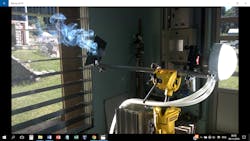1064 nm solar laser achieves record power output and efficiency
With applications in remote sensing from space, wireless laser power beaming, asteroid deflection, and fuel-free photonic thrusters, lasers that emit energy directly through the conversion of sunlight—called solar-pumped lasers—have improved in performance again, thanks to research conducted at the New University of Lisbon (Lisbon, Portugal).
Unlike other architectures that transported laser energy from a solar tracking system via an optical fiber with moderate loss, the Lisbon researchers instead used end-side-pumping of a 4.0-mm-diameter, 35-mm-long neodymium:yttrium aluminum garnet (Nd:YAG) single-crystal rod with a heliostat-parabolic-mirror solar energy concentration system. An aspheric fused-silica lens coupled concentrated solar energy from a 1.4-m-effective-diameter parabolic mirror into the laser rod within a conical pumping cavity, producing 37.2 W of continuous-wave (CW) multimode 1064 nm solar laser power with 8.9% slope efficiency—the highest solar-laser efficiency to date, according to the researchers. In addition, 9.3 W of CW TEM00-mode (m2 ≤1.2) 1064 nm solar laser power was also measured, resulting in a 7.9 W/m2 fundamental-mode laser collection efficiency that is 2.6X and 2.0X higher than the previous Fresnel lens and parabolic mirror records, respectively. Reference: D. Liang et al., Sol. Energ. Mat. Sol. Cells, 159, 435–439 (Jan. 2017).
About the Author

Gail Overton
Senior Editor (2004-2020)
Gail has more than 30 years of engineering, marketing, product management, and editorial experience in the photonics and optical communications industry. Before joining the staff at Laser Focus World in 2004, she held many product management and product marketing roles in the fiber-optics industry, most notably at Hughes (El Segundo, CA), GTE Labs (Waltham, MA), Corning (Corning, NY), Photon Kinetics (Beaverton, OR), and Newport Corporation (Irvine, CA). During her marketing career, Gail published articles in WDM Solutions and Sensors magazine and traveled internationally to conduct product and sales training. Gail received her BS degree in physics, with an emphasis in optics, from San Diego State University in San Diego, CA in May 1986.
